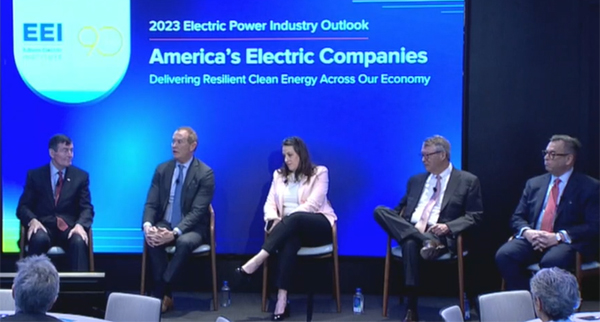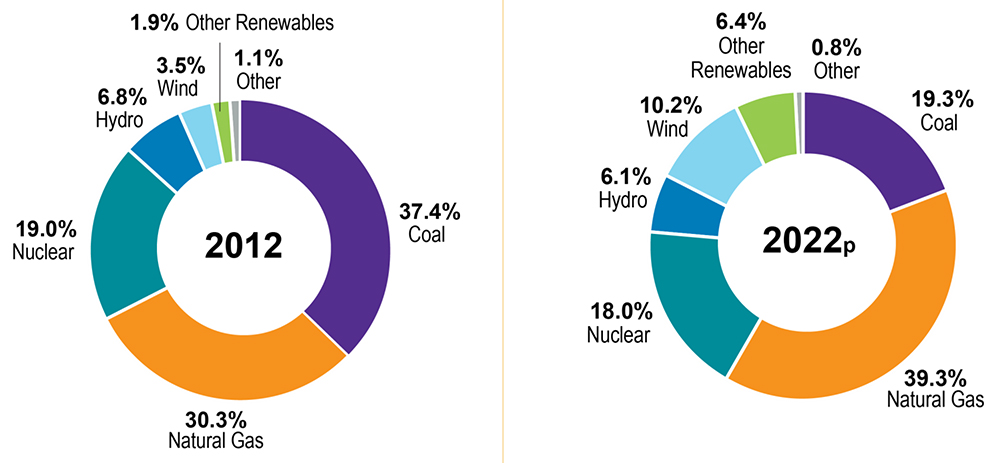
Edison Electric Institute officials said Tuesday they are pursuing a “clean slate” on siting and permitting legislation in Congress and optimistic that they can help craft a bipartisan package after the failure of Sen. Joe Manchin’s (D-W.Va.) proposal last year.
“We’re interested now in what has been described by members of Congress as a clean slate, simply because that [Manchin] proposal didn’t get a lot of support,” Brian Wolff, EEI’s executive vice president for public policy and external affairs, said during the organization’s annual Wall Street briefing. “And we are engaging with Chairman Manchin, but we’re also engaging with House Republicans; we’re really going at this in a different way, so it’s a different process.”
 Appearing at the Edison EIectric Institute’s annual Wall Street briefing were (from left) EEI President Tom Kuhn; Brian Wolff, executive vice president, public policy and external affairs; Emily Sanford Fisher, general counsel; Phil Moeller, executive vice president, business operations and regulatory affairs; and Richard McMahon, senior vice president, energy supply and finance & chief ESG officer. | Edison EIectric Institute
Appearing at the Edison EIectric Institute’s annual Wall Street briefing were (from left) EEI President Tom Kuhn; Brian Wolff, executive vice president, public policy and external affairs; Emily Sanford Fisher, general counsel; Phil Moeller, executive vice president, business operations and regulatory affairs; and Richard McMahon, senior vice president, energy supply and finance & chief ESG officer. | Edison EIectric InstituteWolff said EEI, which represents investor-owned electric utilities, expects to work on the legislation for most of the year, with General Counsel Emily Sanford Fisher seeking to win consensus on a set of “guiding principles.”
The Manchin proposal “at the end of the year was just kind of pushed … very quickly through the process, [so] we really didn’t get a lot of opportunity to make sure that they understood our constructive points,” Wolff said. (See Manchin Permitting Bill Falls Short in Senate.)
Fisher said EEI seeks “basic good governance” changes to provide “certainty that the permits that are issued and the environmental reviews that are completed are durable and can survive legal review.”
EEI President Tom Kuhn said the Republicans who control the House of Representatives and the Democrats controlling the Senate could find their way to a deal.
“The Republicans may want more pipelines approved in a shorter period of time. The Democrats want to make sure that the renewable energy out there can come on at a decent pace and the transmission can be built. So those dynamics are helpful,” Kuhn said.
“We still have the help of environmental groups and industry groups … so we are hopeful. It is complicated, but it is something that we’re all behind, and we’re going to continue to push in a major way,” he added. “I think that [it will lead] to the realization that we’re just wasting a lot of money [and] a lot of time at a period of urgency for us to move forward.”
Philip Moeller, executive vice president of business operations and regulatory affairs, also spoke of “urgency.”
“And not only for the clean energy transition, but resource adequacy issues, congestion issues; as we electrify more, we need more transmission, and we need it sooner rather than later,” he said. “So what accelerates that, and what hinders it and adds to more delays, that’s kind of the lens that I think we look through. …
 The U.S. electric power industry has reduced its reliance on coal and increased its use of natural gas and renewables since 2012, according to data from the Energy Information Administration. | Edison EIectric Institute
The U.S. electric power industry has reduced its reliance on coal and increased its use of natural gas and renewables since 2012, according to data from the Energy Information Administration. | Edison EIectric Institute
“So if there’s legislative language that just kind of confuses things or leads to more litigation, you know, that’s not good. Similarly, if there’s a FERC proposal that sets in another layer, like an independent transmission monitor, is that helping to speed things along? That’s the lens that we have to look through.” (See States Urge More Transparency on Tx Planning, Independent Monitors.)
Moeller also urged policymakers not to “slow up the queue reform that’s already going on in some of the RTOs. They’re on it. Don’t mess it up. That’s kind of been our philosophy.”
Fisher said EEI is seeking regulatory relief in addition to permitting legislation. “There are also things that we can do, both at FERC and [the Department of Energy] and at [the Interior Department] to help accelerate those processes now,” she said. “And so we’re sort of dual tracking a legislative and regulatory effort.”
Moeller, a FERC commissioner from 2006 to 2015, said he was optimistic that stakeholders can overcome the cost allocation challenges that have made interregional transmission difficult.
“It’ll be trickier, but doable, when we talk about projects between regions,” he said, citing SPP and MISO’s Joint Targeted Interconnection Queue projects. (See MISO, SPP Update Stakeholders on Joint Tx Planning.)
“Those are solvable problems with the right people at the table with the right attitude,” Moeller said “If you look kind of what’s going on in SPP and MISO, [the] right attitude, right commitment can make things happen.”

